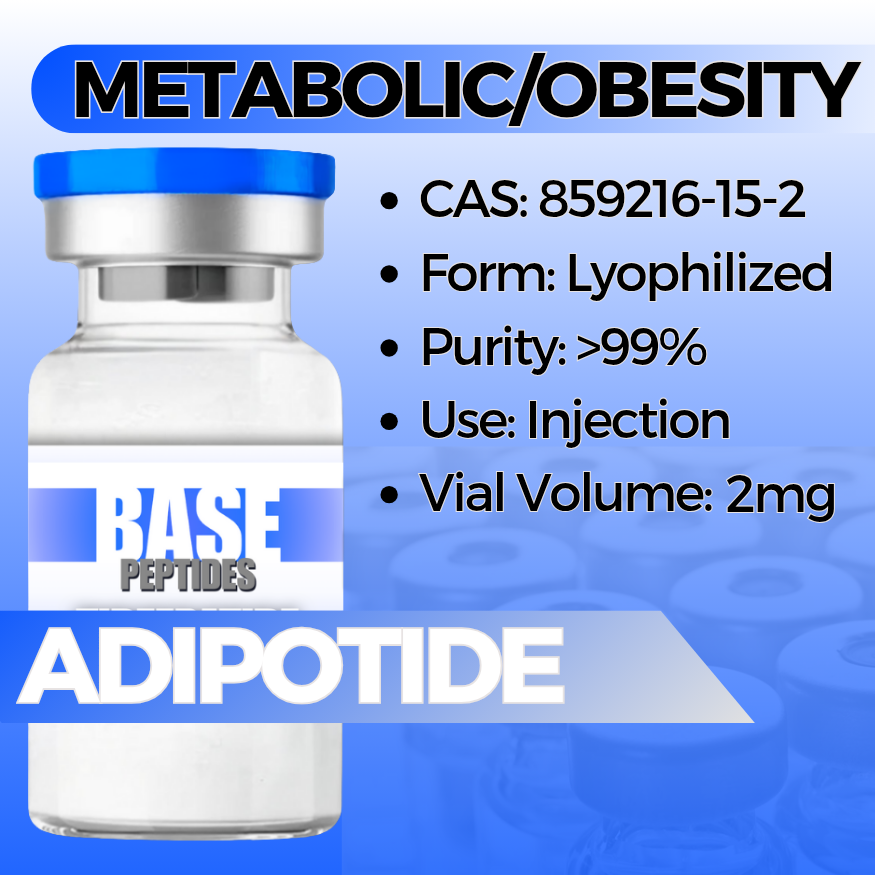Adipotide
Adipotide
Base Peptides are intended for licensed medical professionals and experienced researchers. Reconstitution required. Dosing and use instructions are not provided.
Couldn't load pickup availability
Adipotide (FTPP / Prohibitin-TP01)
High-purity research-grade peptidomimetic designed to selectively target the vasculature of white adipose tissue for experimental studies of adiposity, vascular biology, and metabolic regulation.
- CAS / CID: 859216-15-2 (per investigation)
- Synonyms: FTPP, Prohibitin-TP01
- Sequence: Cys-Lys-Gly-Gly-Arg-Ala-Lys-Asp-Cys-GG-D(KLAKLAK)₂
- Molecular Weight: ~2,611 g/mol (per vendor)
- Form: Lyophilized powder for research use only
Adipotide was developed via peptide-mimetic design to specifically target and disable the blood vessels that supply white adipose tissue (WAT). Research uncovered a ligand for receptors such as Prohibitin and Annexin A2 on WAT vasculature-endothelial cells, enabling selective vascular ablation of fat tissue.
- Initial preclinical study: Reversal of obesity by targeted ablation of adipose tissue (2004, mice) showed marked fat loss.
- Clinical translation: IND accepted by Arrowhead Research Corporation for Phase I in 2012 for obesity/vascular fat supply.
- Storage: −20 °C, desiccated, protected from light and moisture.
- Stability: Use aliquots if available; minimize freeze-thaw cycles.
- Usage for research: For laboratory research only. Not for clinical or human use.
Key Study Highlights (Readable Overview)
White Adipose Tissue Vascular Ablation
- In obese rhesus monkeys treated with Adipotide, researchers observed ~30% reduction in body weight over a short period; targeted fat-loss associated with improved insulin sensitivity.
- The mechanism: peptide binds WAT endothelial receptors, triggers apoptosis of microvasculature, leads to ischemia and fat-cell death.
- Notably, improvements in glucose tolerance observed sometimes independent of large weight loss.
Preclinical & Translation Data
- Mouse and primate models: daily injections resulted in rapid reduction in visceral white fat and supporting vasculature. 15
- Clinical trial entry: Phase I launched to assess safety in humans, though broader efficacy and approval remain open. 16
Potential Research Applications
- Metabolic research: Studies on adiposity, insulin resistance, fat-vascular interface.
- Vascular biology: Model for selective endothelial targeting in adipose tissue or non-traditional vascular beds.
- Angiogenesis/Oncology model: Because WAT vasculature shares features with tumour vasculature, Adipotide has been explored for vascular-targeted interventions. 17
Research-use only. Not intended for human therapeutic application.
Synergistic / Comparator Peptides
Cagrilintide & Glucagon/GLP-1 Analogues
Pair for comparative metabolic-fat-loss research.
GHK-Cu / Matrix-Support Peptide
Use in experiments combining fat-reduction + tissue-remodeling protocols.
TB-500 or BPC-157
Alternate model of tissue repair/hydration to contrast with fat-vascular ablation pathways.
Known Concerns & Responsible Use
- Mechanism involves vascular ablation; off-target vascular effects must be considered in research protocols.
- Preclinical models show strong effects, but human safety/efficacy remain unconfirmed.
- Research-only: Not approved for human therapeutic use; studies should follow institutional and regulatory guidelines.
Specifications
| Appearance | White to off-white lyophilized powder |
|---|---|
| Purity (HPLC/MS) | ≥ 99% (lot-specific) — see header above |
| Sequence | Cys-Lys-Gly-Gly-Arg-Ala-Lys-Asp-Cys-GG-D(KLAKLAK)₂ |
| Solubility | Typically e.g., sterile water or buffer (research grade) |
| Storage | −20 °C, desiccated, protected from light |
| Volume | 2mg |
Adipotide FTPP Research Peptide | White Fat Vascular Targeting | Selective Endothelial Ablation | ≥99% Purity


